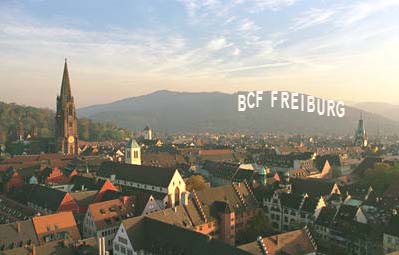Jan Schulz (Department of Physiology, University of Bern, Switzerland)
"Visual inputs to the striatum and their role in reinforcement learning" / Monday, September 27, 2010, 17:15 h
The Bernstein Center Freiburg Bernstein Seminar |  |
Jan M. Schulz Department of Physiology University of Bern, Switzerland Visual inputs to the striatum and their role in reinforcement learning | |
Monday, September 27, 2010 17:15 h | Lecture Hall (ground floor) Bernstein Center Freiburg Hansastraße 9A 79104 Freiburg |
Abstract: The striatum, the major input nucleus of the basal ganglia, is implicated in learning when sensory feedback reinforces useful actions. The superior colliculus (SC) integrates visual inputs with information from all other sensory modalities and, thus, serves as an early detector of salient events. Anatomical and electrophysiological evidence suggests that the SC may rapidly convey this information to the striatum via thalamic and dopaminergic pathways. I investigated this hypothesis during my PhD thesis research in the lab of Dr. John Reynolds, University of Otago. Neurons were recorded intracellularly, using sharp micropipettes, in the striatum of urethane-anaesthetised rats. Light flash stimulation of the contra¬lateral eye evoked sizeable visual responses in striatal neurons, only after pharmacological disinhibition of the SC. In the principal spiny neurons, visual responses consisted of immediate depolarising transitions to the Up state at latencies of ~120 ms. These responses were delayed by ~100 ms after pharmacological inhibition of the parafascicular nucleus of the thalamus, but remained unaffected after blocking dopaminergic or visual cortical inputs. The same inputs also activated cholinergic interneurons. In contrast to spiny neurons, visual-evoked inputs consistently modulated the spike output of these neurons, evoking a transient spike rate elevation followed by a pause in spiking. To test the hypothesis that tecto-striatal pathways convey a sensory reinforcement signal, cortico-striatal inputs were experimentally paired with delayed visual-evoked inputs. Induced changes in cortical-evoked postsynaptic potentials (PSP) ranged from moderate potentiation to depression in a spike-timing dependent fashion. These results support the idea that inputs from converging tecto-striatal pathways contribute to cellular mechanisms of reinforcement learning in the striatum. | |
Host: Carsten Mehring | |
| The talk is open to the public. Guests are cordially invited! www.bcf.uni-freiburg.de | |
abgelegt unter:
Bernstein Seminar

